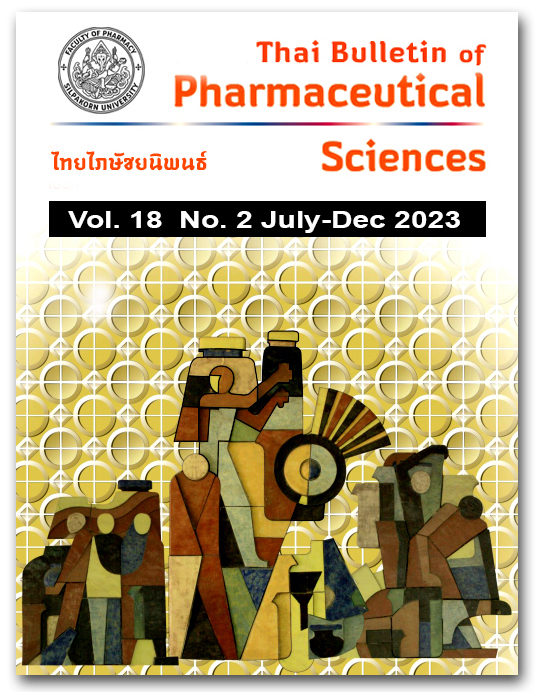THE ROLE OF ROS IN ATHEROSCLEROSIS AND ANTIOXIDANT
DOI:
https://doi.org/10.69598/tbps.18.2.69-79Keywords:
ROS, atherosclerosis, antioxidantsAbstract
Living organisms require oxygen to sustain their existence, and oxidative compounds such as reactive oxygen species (ROS) and reactive nitrogen species (RNS) in cells are produced from molecular oxygen as a consequence of aerobic metabolism. ROS can be classified as either free radicals (radicals) or non-radicals (paired with electrons). Free radicals are molecules with one or more lone pairs of electrons. Therefore, they have the agility to react by receiving electrons from other substances nearby, resulting in self-stabilization. This causes other substances that lose or gain electrons to become new free radicals and will react with other substances in a chain reaction. Generating a large number of free radicals (ROS) causes cell injury, which is an important mechanism that causes various pathologies such as high blood pressure, diabetes mellitus, hypercholesterolemia, heart attack and atherosclerosis. Atherosclerosis is associated with the deterioration of lipids and hardening of the arteries. It is a disease associated with chronic inflammation, thickening and hardening of the blood vessels which is the main cause of coronary heart disease and stroke, including myocardial infarction. It is recognized that ROS plays an important role in atherosclerosis. This disrupts the equilibrium of vascular endothelial cells, which are important steps involved in fatty streak formation, atheroma induction and atherosclerotic plaques leading to thrombosis. Antioxidants are molecules that can neutralize the oxidation of ROS before they interact with cellular biomolecules, causing structural or functional changes. Antioxidants are a defense system. They are divided into two levels; 1) primary defense mechanism, a defense mechanism that directly inhibits oxidative damage by repelling free radicals before they cause molecular damage within cells. 2) secondary defense mechanism (chain-breaking defense) includes vitamin C, vitamin E and uric acid.
References
Matei D, Buculei I, Luca C, Corciova C-P, Andritoi D, Fuior R, et al. Impact of non-pharmacological interventions on the mechanisms of atherosclerosis. Int J Mol Sci. 2022;23:1-26.
Malekmohammad K, Sewell RDE, Rafieian-Kopaei M. Antioxidants and atherosclerosis: Mechanistic aspects. Biomolecules. 2019;9:1-19.
Frak W, Wojtasiriska A, Lisiriska W, Miynarska E, Franczyk B, Rysz J. Pathophysiology of cardiovascular diseases: new insights into molecular mechanisms of atherosclerosis, arterial hypertension, and coronary artery disease. Biomedicines. 2022;10:1-17.
Verma S, Singh P, Khurana S, Ganguly NK, Kukreti R, Saso L. Implications of oxidative stress in chronic kidney disease: a review on current concepts and therapies. Kidney Res Clin Pract. 2021;40(2):183-193.
Halliwell B. Current Status Review: Free radicals, reactive oxygen species and human disease: a critical evaluation with special reference to atherosclerosis. Br J Exp Path. 1989;70:737-757.
Kulesza KA, Oniszczuk A, Oniszczuk T, et al. The influence of common free radicals and antioxidants on development of Alzheimer’s disease. Biomed Pharmacother. 2016;78:39-49.
Mimic-Oka J, Simic DV, Simic TP. Free radicals in cardiovascular diseases. Med Biol. 1999;6(1):11-22.
Young IS, Woodside JV. Antioxidants in health and disease. J Clin Pathol. 2001;54:176-186.
Khan F, Butler R. Free radicals in cardiovascular disease. Proc R Coll Physicians Edinb. 1998;28:102-110.
Bahorun T, Soorattee MA, Luimon-Ramma V, et al. Free radicals and antioxidants in cardiovascular health and disease. Internet J Med Update. 2006;1(2):25-41.
Vogiatzi G, Tousoulis D, Stefanadis C. The role of oxidative stress in atherosclerosis. Hellenic J Cardiol. 2009;50:402-409.
Park J-G, Oh GT. The role of peroxidases in the pathogenesis of atherosclerosis. BMB Rep. 2011;44(8):497-505.
Bonomini F, Tengattini S, Fabiano A, et al. Atherosclerosis and oxidative stress. Histol Histopathol. 2008;23:381-390.
Demirbas AB, Yesilkaya B. Oxidative stress, atherosclerosis and dietary recommendations. Akd Med J. 2022;8(1):101-108.
Chen X, Guo X, Ge Q, Zhao Y, Mu H, Zhang J. ER stress activates the NLRP3 inflammasome: A novel mechanism of atherosclerosis. Oxid Med Cell Longev. 2019:1-18.
Tucker WD, Arora Y, Mahajan K. Anatomy, Blood Vessels. StatPearls [Internet]. 2022 [cited on 20 March 2023]. Available from: https://www.ncbi.nlm.nih.gov/books/ NBK470401/
Yang X, Li Y, Ren X, et al. Oxidative stress-mediated atherosclerosis: mechanisms and therapies. Front Physiol. 2017;8:1-15.
Lewis Y. Atherosclerosis and antioxidants. Sci J Lander Coll Arts Sci. 2010;3(1);58-69.
Niki E. Do free radicals play causal role in atherosclerosis? Low density lipoprotein oxidation and viamin E revisited. J Clin Biochem Nutr. 2011;48(1):3-7.
Poznyak AV, Grechko AV, Orekhova VA, Chegodaev YS, Wu W-K, Orekhov AN. Oxidative stress and antioxidants in atherosclerosis development and treatment. Biology (Basel). 2020;9(60):1-14.
Perrotta I, Aquila S. The role of oxidative stress and autophagy in atherosclerosis. Oxid Med and Cell Longev. 2015:1-10.
Edae KC, Tofik E. Biomarkers of oxidative stress and its role in atherosclerosis development. Biomed J Sci Tech Res. 2020;32(1):24659-24669.
Toledo-Ibelles P, Mas-Oliva J. Antioxidants in the fight against atherosclerosis: Is this a dead end? Curr Atheroscle Rep. 2018;20(36):1-12.
Scheicher E, Friess U. Oxidative stress, AGE, and atherosclerosis. Kidney Int. 2007;72:S17-S26.
Yamada N. Atherosclerosis and oxidative stress. Japan Med Assoc J. 2001;44(12):529-534.
Kumar S, Pandey AK. Free radicals: Health implications and their mitigation by herbals. Br J Med Med Res. 2015;7(6):438-457.
Downloads
Published
How to Cite
Issue
Section
License
All articles published and information contained in this journal such as text, graphics, logos and images is copyrighted by and proprietary to the Thai Bulletin of Pharmaceutical Sciences, and may not be reproduced in whole or in part by persons, organizations, or corporations other than the Thai Bulletin of Pharmaceutical Sciences and the authors without prior written permission.



